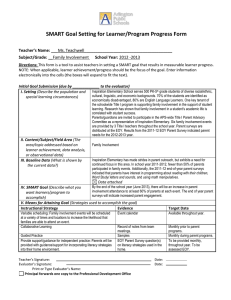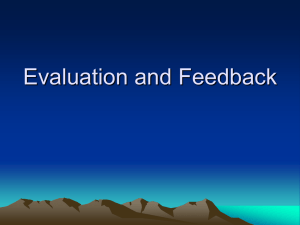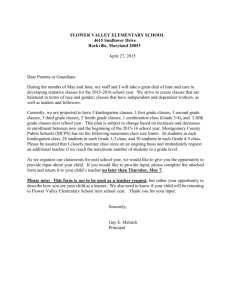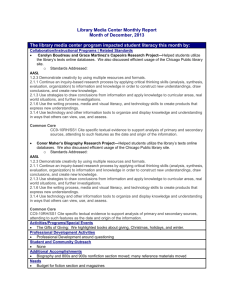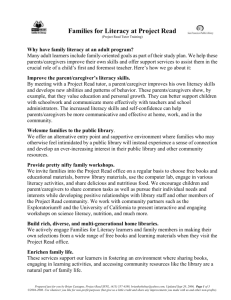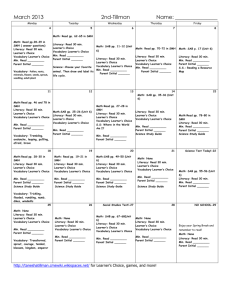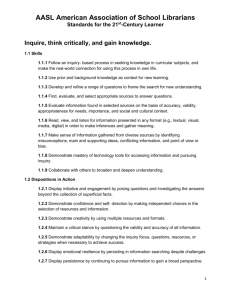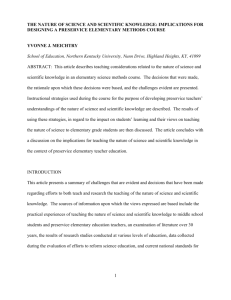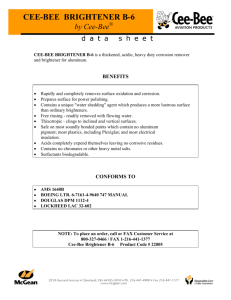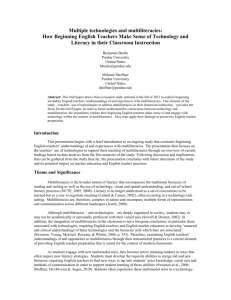ERDG 617 Teaching Social Studies, B-6
advertisement
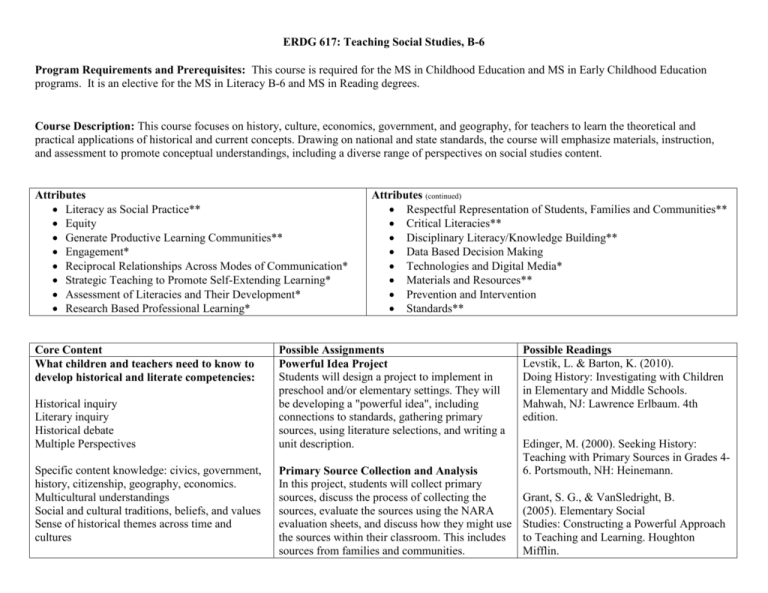
ERDG 617: Teaching Social Studies, B-6 Program Requirements and Prerequisites: This course is required for the MS in Childhood Education and MS in Early Childhood Education programs. It is an elective for the MS in Literacy B-6 and MS in Reading degrees. Course Description: This course focuses on history, culture, economics, government, and geography, for teachers to learn the theoretical and practical applications of historical and current concepts. Drawing on national and state standards, the course will emphasize materials, instruction, and assessment to promote conceptual understandings, including a diverse range of perspectives on social studies content. Attributes Literacy as Social Practice** Equity Generate Productive Learning Communities** Engagement* Reciprocal Relationships Across Modes of Communication* Strategic Teaching to Promote Self-Extending Learning* Assessment of Literacies and Their Development* Research Based Professional Learning* Core Content What children and teachers need to know to develop historical and literate competencies: Historical inquiry Literary inquiry Historical debate Multiple Perspectives Specific content knowledge: civics, government, history, citizenship, geography, economics. Multicultural understandings Social and cultural traditions, beliefs, and values Sense of historical themes across time and cultures Attributes (continued) Respectful Representation of Students, Families and Communities** Critical Literacies** Disciplinary Literacy/Knowledge Building** Data Based Decision Making Technologies and Digital Media* Materials and Resources** Prevention and Intervention Standards** Possible Assignments Powerful Idea Project Students will design a project to implement in preschool and/or elementary settings. They will be developing a "powerful idea", including connections to standards, gathering primary sources, using literature selections, and writing a unit description. Primary Source Collection and Analysis In this project, students will collect primary sources, discuss the process of collecting the sources, evaluate the sources using the NARA evaluation sheets, and discuss how they might use the sources within their classroom. This includes sources from families and communities. Possible Readings Levstik, L. & Barton, K. (2010). Doing History: Investigating with Children in Elementary and Middle Schools. Mahwah, NJ: Lawrence Erlbaum. 4th edition. Edinger, M. (2000). Seeking History: Teaching with Primary Sources in Grades 46. Portsmouth, NH: Heinemann. Grant, S. G., & VanSledright, B. (2005). Elementary Social Studies: Constructing a Powerful Approach to Teaching and Learning. Houghton Mifflin. Evaluating texts for historical validity, reliability, and significance Instructional and Assessment Materials Choosing appropriate literature NYS standards, curriculum guides, assessment Common Core Standards Variety of Primary Sources, Secondary sources Moving beyond historical fiction Use historical evidence and analysis it for reliability, significance, and validity. Contexts of Learning Develop Interdisciplinary practices Use instruction situated around "powerful ideas" to guide conceptual understandings Developing Pedagogical Knowledge Develop a sense of what students know, the basis for their idea/understandings, and methods to move the thinking forward Collaborating for problem solving and examining assumptions Engaging in reflective teaching Developing a culture that promotes selfextending learning Accessing and evaluating technology related resources Final Exam Students may have a final exam requiring them to synthesize content from across the course in response to questions/issues. Selected Children’s Literature Museum Centers Students gather primary source and educational information/materials from a local museum, historical center, or state park and interview a staff member. Then, produce a written project connecting these sources to standards and curriculum guides. NYS Common Core Learning Standards for ELA & Literacy (2011) NYS Social Studies Core Curriculum with Resource Guide (1999) Ereserves with articles primarily from: Social Studies and the Young Learner Social Education Educational Leadership Language Arts Reading Teacher Sample Articles: Potter, L.A. (2009). Teaching with documents, documents, and more documents.: The National Archives Digital Partnerships. Social Education 73(3), 109112. Risinger, C.F. (2010). Using online field trips and tours in social studies. Social Education, 74 (3), 137-138. Berson, I.E. (2009). Here’s what we have to say! Podcasting in the early childhood classroom. Social Studies and the Young Learner, 21 (4), 8-11. Barnes, M.K., Johnson, E.C., Neff, L. (2010). Learning through process drama in the first grade. Social Studies and the Young Learner, 22 (4), 19-24. White, W.E. (2010). Historic sites and your students. Social Education 74 (2), 74-75. Williams, T. (2009). A closer look: The representation of slavery in the Dear America series. Social Studies and the Young Learner, 21 (3), 26-29. Meyers, L.E., Holbrook, T., May, L.A. (2009). Beyond heroes and role models: Using biographies to develop young change agents. Social Studies and the Young Learner, 21 (3), 10-14. Oldendor, S. B., Calloway, A. (2008). Connecting children to the bigger world: Reading newspapers in second grade. Social Studies and the Young Learner, 21 (2), 17-19.





